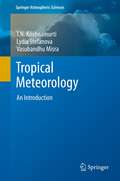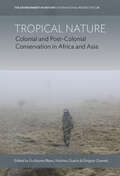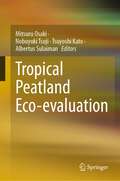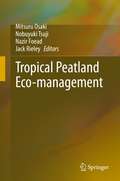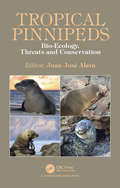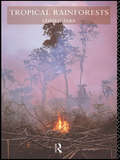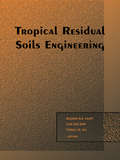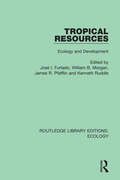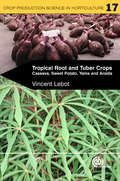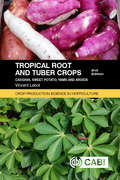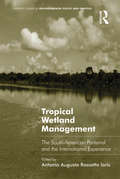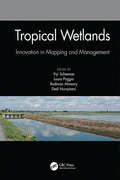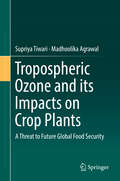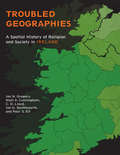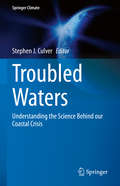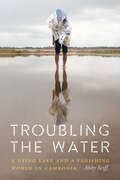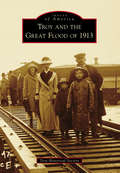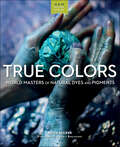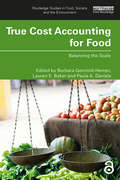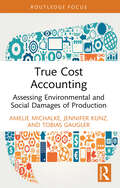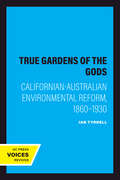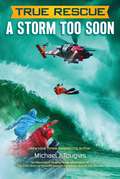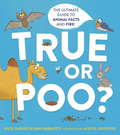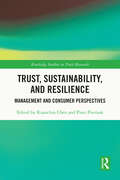- Table View
- List View
Tropical Meteorology: An Introduction
by Lydia Stefanova T. N. Krishnamurti Vasubandhu MisraThis book is designed as an introductory course in Tropical Meteorology for the graduate or advanced level undergraduate student. The material within can be covered in a one-semester course program. The text starts from the global scale-view of the Tropics, addressing the zonally symmetric and asymmetric features of the tropical circulation. It then goes on to progressively smaller spatial and time scales - from the El Niño Southern Oscillation and the Asian Monsoon, down to tropical waves, hurricanes, sea breezes, and tropical squall lines. The emphasis in most chapters is on the observational aspects of the phenomenon in question, the theories regarding its nature and maintenance, and the approaches to its numerical modeling. The concept of scale interactions is also presented as a way of gaining insight into the generation and redistribution of energy for the maintenance of oscillations of a variety of spatial and temporal scales.
Tropical Nature: Colonial and Post-Colonial Conservation in Africa and Asia (Environment in History: International Perspectives)
by Guillaume Blanc, Mathieu Guérin and Grégory QuenetAcross Africa and South-East Asia, the impulse to protect nature often dovetails with the domination of local people. From mass displacement to severe restrictions on land use and daily acts of violence, conservation work risks reproducing Eurocentric modes of colonialism and worsening the effects of the climate crisis. In this insightful and wide-ranging study of the colonial history of conservation, Tropical Nature seeks to provide a much-needed history of the Global South from its own perspective. Comparing case studies ranging from Ali Bongo’s Gabon, to the postcolonial African itinerary of the agronomist Arthur Bunting, this volume advances a “small-scale global history” that deciphers the relations binding human societies to the non-human world.
Tropical Peatland Eco-evaluation
by Mitsuru Osaki Nobuyuki Tsuji Tsuyoshi Kato Albertus SulaimanThis book focuses on eco-evaluation system monitoring and sensing, carbon-water modeling, mapping, and disaster prediction. It is the 3rd book on tropical peatland issues, following 1st "Tropical Peatland Ecosystem" and 2nd "Tropical Peatland Eco-management" publications. Tropical peatland is also a wetland, mangrove, and rainforest. With this nature, two major key elements of tropical peatland are water and forest. This book introduces the relationship and interaction among water, oxygen, and nutrients as well as aspects of the forest as the driving force of carbon stock and the carbon cycle. Eco-evaluation system is key to conserving, managing, and restoring tropical peatlands, however comprehensive system for Eco-evaluation in the Tropics is not yet established. This book reviews and proposes Eco-evaluation methods in the Tropics Ecosystem, focusing mainly on the peatland ecosystem and others, covering Social Capital such as Credit, Bonds, National Accounting, etc.
Tropical Peatland Eco-management
by Mitsuru Osaki Nobuyuki Tsuji Nazir Foead Jack RieleyIn this "Tropical Peatland Eco-management" book, eco-management is new terminology as an abbreviation of "ecology-based management for natural capital enhancement". Key concept on this eco-management is derived from previous book: "Tropical Peatland Ecosystem"(Springer, 2015, eds. by M. Osaki and N. Tsuji). Based on this new concept, this book thoroughly examines tropical peatland eco-management for scientists, political decision makers, governmental officials, land managers, students, and NGO/NPOs who are interested in 1) what the impact of peatland on climate change and ecosystem function, 2) how the management of disturbed peatland, and 3) drawing global scale restoration mechanisms of peatland and wetland. In tropical peatland, a large amount of GHGs (carbon dioxide, methane, and nitrous oxide) is emitted due to the unappropriate development and inadequate management of peatland. The peatland ecosystems consist of the carbon–water complex, which is affected easily by the impact of human and climate change. Throughout much research of tropical peatland, the problems that result from development of tropical peatland are found to stem mainly from a lack of understanding of the complexities of this ecosystem and the fragility of the relationship between peat and forest and also between carbon and water. In past, almost all peatland development and management system have been generally designed on “water drainage system”. On the contrast of old system, an innovated eco- management is, here, proposed as “water irrigation system”, including water cycling and natural capital enhancement. Through this book readers will learn the advanced peatland eco-management, with more practical methods and procedure based on ecosystem knowledge.
Tropical Pinnipeds: Bio-Ecology, Threats and Conservation
by Juan J. AlavaPinnipeds are a fascinating group of marine mammals that play a crucial role as apex predators and sentinels of the functioning and health of marine ecosystems. They are found in the most extreme environments from the Polar regions to the tropics. Pinnipeds are comprised of about 34 species, and of those at least 25% live permanently in tropical zones. This book reviews and updates current research on the biology, marine ecology, bio-monitoring, and conservation of tropical pinniped populations, including their behavior, anthropogenic stressors, and health. It also looks at challenges to be faced for the conservation of tropical pinnipeds, many of which are threatened species.
Tropical Rainforests
by Chris C. ParkFirst published in 1992. Routledge is an imprint of Taylor & Francis, an informa company.
Tropical Residual Soils Engineering
by Bujang B. K. Huat Gue See Sew Faisal Haji AliFocused on tropical areas and their unique problems and issues, this work examines all aspects of residual soils engineering, including both theoretical and practical aspects. This book gives the practitioner a thorough understanding of the characteristics of these soil types, their formation and their material properties, while guidelines on appli
Tropical Resources: Ecology and Development (Routledge Library Editions: Ecology #3)
by Kenneth Ruddle José I. Furtado William B. Morgan James R. PfafflinOriginally published in 1990 Tropical Resources presents in-depth coverage of the extremely diverse tropical environments, the resources to be found within the region and their production, and ecological management. The book discusses economic geography and ways of utilizing available resources, including those of tropical forests, wildlife, tidal wetlands and the sea. The book also include chapters on the development and land use of protected areas, the ecological aspects of pasture resources; and the impacts of economic development and population damage. In addition, studies are offered on tropical soils, including their distribution properties and management and the ecological processes at work in tropical forests. For geographers, economists and policymakers, the book provides a wealth of information on tropical resources and their potential development.
Tropical Root and Tuber Crops: Cassava, Sweet Potato, Yams and Aroids
by Vincent LebotMost of the world's poorest smallholders depend on tropical roots and tubers crops as their principal source of food and nutrition. These species produce large quantities of dietary energy and have stable yields under difficult environmental conditions. The most important crops are cassava, sweet potato, yam and the aroids, sharing important common traits such as bulkiness, post-harvest perishability and vegetative propagation. This book compiles the most up-to-date information on the origin, genetics, physiology, agronomy, pests and diseases and postharvest processing of these crops, while attempting to provide ideas for further research and development.
Tropical Root and Tuber Crops: Cassava, sweet potato, yams and aroids (Crop Production Science in Horticulture #No. 17)
by Vincent LebotRoot and tuber crops are important to agriculture, food security and income for 2.2 billion people in developing countries. These species produce large quantities of dietary energy and have stable yields under difficult environmental conditions. This second edition of Tropical Root and Tuber Crops is an authoritative treatment of four important root and tuber crops: cassava. sweet potato, yams, and aroids. The same format is followed for each crop: Origin and History, Taxonomy and Botany, Breeding and Genetics, Developmental Physiology, Agronomy, Pests and Diseases, Post-Harvest Quality and Marketing. This new edition reviews the scientific literature produced during the last decade and presents major technical advancements. Modern molecular tools have been used to clarify the phylogeny, taxonomy and origin of these species. Similar advances have been made in physiology, agronomy, pathology and product chemistry. It is essential reading for students, researchers and horticulturists.
Tropical Wetland Management: The South-American Pantanal and the International Experience (Routledge Studies in Environmental Policy and Practice)
by Antonio Augusto Rossotto IorisRecent scientific development and politico-institutional experiences related to the conservation of the South-American Pantanal are explored in this book in relation to what is happening in other tropical wetland areas of international importance such as the Everglades in North America and the Okavango in Africa, as well as considering the European experience. An interdisciplinary group of authors examines the need to establish a constructive dialogue between scientists, policy-makers and local stakeholders and outline a future research agenda, including consideration of the impacts of climate change and the pressures of regional development, for wetland management.
Tropical Wetlands - Innovation in Mapping and Management: Proceedings of the International Workshop on Tropical Wetlands: Innovation in Mapping and Management, October 19-20, 2018, Banjarmasin, Indonesia
by Budiman Minasny Yiyi Sulaeman Laura Poggio Dedi NursyamsiThis book contains papers presented at the International Workshop on Tropical Wetlands, held in Banjarmasin, Indonesia. This workshop discussed wetland mapping and characterization as well as wetland management for sustainable agriculture. This volume contains selected papers on tropical wetlands, more specifically, peatland, tidal land, and acid sulphate soils.This book presents an international overview of wetland and peatland mapping experiences from Indonesia, Congo, Brazil, Australia, and Scotland. Several innovative techniques are discussed, including integrated digital soil mapping and remote sensing techniques, as well as geodatabase processing and field surveying. This book further discussed tropical wetland management for agriculture as practiced in Indonesia, Vietnam, and Thailand.The contents of this book are suitable and should be a good reference for those who are involved in research, development, and management of tropical wetland, including academics, soil scientists, environmentalists, researchers, agriculturists, students, agri-businessmen, policy makers, land managers and farmers.
Tropospheric Ozone and its Impacts on Crop Plants: A Threat To Future Global Food Security
by Supriya Tiwari Madhoolika AgrawalThe research and its outcomes presented here focuses on tropospheric or ground level ozone, in particular due to its surfacing as a major threat to crop productivity around the world. This book presents the ozone concentration data for a variety of geographical regions, examines the factors responsible for its increasing concentrations and its potential effects on physiological and biochemical responses culminating in crop productivity losses which, in turn may pose a serious threat to global food security. Beside this, certain ameliorative measures that could be adopted to assess ozone injury in plants are also discussed.Global climate change scenarios predict a significant increase in future tropospheric ozone concentration. Particular attention is therefore given to evaluate the effect of global climate change on ozone concentrations. Readers will also discover how yield losses due to ozone are related to changes in the socio-economic conditions of the society, especially in South Asian regions. Students and researchers studying crop and soil science, environmental scientists, risk assessment professionals and policy makers will find this book of interest.
Troubled Geographies: A Spatial History of Religion and Society in Ireland (The Spatial Humanities)
by Ian N. Gregory Niall A. Cunningham Ian G. Shuttleworth Paul S. Ell C. D. Lloyd&“Tap[s] the power of new geospatial technologies . . . explore[s] the intersection of geography, religion, politics, and identity in Irish history.&”—International Social Science Review Ireland&’s landscape is marked by fault lines of religious, ethnic, and political identity that have shaped its troubled history. Troubled Geographies maps this history by detailing the patterns of change in Ireland from 16th century attempts to &“plant&” areas of Ireland with loyal English Protestants to defend against threats posed by indigenous Catholics, through the violence of the latter part of the 20th century and the rise of the &“Celtic Tiger.&” The book is concerned with how a geography laid down in the 16th and 17th centuries led to an amalgam based on religious belief, ethnic/national identity, and political conviction that continues to shape the geographies of modern Ireland. Troubled Geographies shows how changes in religious affiliation, identity, and territoriality have impacted Irish society during this period. It explores the response of society in general and religion in particular to major cultural shocks such as the Famine and to long term processes such as urbanization. &“Makes a strong case for a greater consideration of spatial information in historical analysis―a message that is obviously appealing for geographers.&”—Journal of Interdisciplinary History &“A book like this is useful as a reminder of the struggles and the sacrifices of generations of unrest and conflict, albeit that, on a global scale, the Irish troubles are just one of a myriad of disputes, each with their own history and localized geography.&”—Journal of Historical Geography
Troubled Waters: Understanding the Science Behind our Coastal Crisis (Springer Climate)
by Stephen J. CulverThe book communicates coastal geology such that the reader gets a better understanding of how scientists work and how scientific knowledge is acquired and how it progresses. It presents the human side of geologic research, including missteps, in this case, research on coastal change of the recent past, the present, and the near future. The audience for this volume is the general public, coastal managers, politicians, and decision makers in general, in the coastal realm. But the implications of this work with regard to future climate change and human responses are relevant globally.
Troubling the Water: A Dying Lake and a Vanishing World in Cambodia
by Abby SeiffIn this intimate account of one of the world&’s most productive inland fisheries, Troubling the Water explores how the rapid destruction of a single lake in Cambodia is upending the lives of millions. The abundance of Cambodia&’s Tonle Sap Lake helped grow the country for millenia and gave rise to the Kingdom of Angkor. Fed by the rich, mud-colored waters of the powerful Mekong River, the lake owes its vast bounty to an ecological miracle that has captivated poets, artisans, and explorers throughout history. But today, the lake is dying. Hydropower dams hold back billions of gallons of water and disrupt critical fish migration paths. On the lake, illegal fishing abetted by corruption is now unstoppable. A fast-changing climate, meanwhile, has seen a string of devastating droughts.Troubling the Water follows ordinary Cambodians coping with the rapid erasure of a long-held way of life. Drawing on years of reporting in Cambodia, Abby Seiff traces the changes on the Tonle Sap—weaving together vivid stories of those most affected with sharp insight into one of the most threatened lakes in the world. For the millions who depend on it, the stakes couldn&’t be higher.
Troy and the Great Flood of 1913
by Troy Historical SocietyThe rain began to fall on Easter Sunday, March 23, 1913. In Troy, 15 people lost their lives during the flood due to drowning, and in the weeks and months that followed an unknown number died from flood-related diseases. The story of what happened in Troy has often been overlooked, but in 1976 the Troy Historical Society Oral History Committee interviewed Troy flood survivors as a project for the bicentennial of the United States. These interviews, preserved on audiotapes, provide researchers firsthand accounts of what happened in the town. The late Mrs. Lois Shilling Davies, a past president of the Troy Historical Society who lived in Troy during the flood, deserves much of the credit for this invaluable resource, for it is she who conducted many of the interviews. Images of America: Troy and the Great Flood of 1913 relates how residents endured without having any instruction or experience in emergency preparedness. This is a celebration of human bravery, kindness, and ingenuity--of people who triumphed over tragedy.
True Colors: World Masters of Natural Dyes and Pigments
by Keith ReckerThis updated 2nd edition features a revised chapter. True Colors is about artists who create color from natural materials and about the historical importance and environmental sustainability of this practice. Deep conversations with 26 artisans from every part of the globe reveal their wisdom, traditions, and know-how—and suggest that we ignore what they know at our peril. Traditional approaches to making color offer sustainable options to a fashion system badly in need of them and memorable cultural narratives to a world hungry for beauty and spirituality. True Colors provides an immersive visual experience and an inspiring travelogue of personal stories and practical information from artists who are leaving their mark on the world.
True Cost Accounting for Food: Balancing the Scale (Routledge Studies in Food, Society and the Environment)
by Barbara Gemmill-HerrenThis book explains how True Cost Accounting is an effective tool we can use to address the pervasive imbalance in our food system. Calls are coming from all quarters that the food system is broken and needs a radical transformation. A system that feeds many yet continues to create both extreme hunger and diet-related diseases, and one which has significant environmental impacts, is not serving the world adequately. This volume argues that True Cost Accounting in our food system can create a framework for a systemic shift. What sounds on the surface like a practice relegated to accountants is ultimately a call for a new lens on the valuation of food and a new relationship with the food we eat, starting with the reform of a system out of balance. From the true cost of corn, rice and water, to incentives for soil health, the chapters economically compare conventional and regenerative, more equitable farming practices in and food system structures, including taking an unflinching look at the true cost of cheap labour. Overall, this volume points towards the potential for our food system to be more human-centred than profit-centred and one that has a more respectful relationship to the planet. It sets forth a path forward based on True Cost Accounting for food. This path seeks to fix our current food metrics, in policy and in practice, by applying a holistic lens that evaluates the actual costs and benefits of different food systems, and the impacts and dependencies between natural systems, human systems, agriculture and food systems. This volume is essential reading for professionals and policymakers involved in developing and reforming the food system, as well as students and scholars working on food policy, food systems and sustainability.
True Cost Accounting: Assessing Environmental and Social Damages of Production (Routledge Focus on Environment and Sustainability)
by Jennifer Kunz Amelie Michalke Tobias GauglerThis book explores the historical and theoretical classification of True Cost Accounting (TCA) and its business-oriented ways of implementation.Tobias Gaugler, Jennifer Kunz, and Amelie Michalke provide compact and comprehensible insights into TCA, which is one approach used to comprehensively assess actual (human or natural) resource consumption and implement this assessment into companies’ internal controlling. To achieve this goal, the volume locates this approach in existing economic theory and shows its historical roots and progressions. The authors then present different methodological approaches within TCA and highlight how practitioners might implement these approaches in their business. To illustrate the importance of TCA, a number of practical examples that are already present in the market are also featured.This volume will be of great interest to students and scholars of environmental economics. Further, practitioners in (sustainable) supply chain management, as well as ecological and social accounting and controlling, can use it for inspiration and guidance. Additionally, this book and the inherent ideas will give policymakers in economic and social politics recommendations for action.
True Gardens of the Gods: Californian-Australian Environmental Reform, 1860–1930
by Ian TyrrellOne of the most critical environmental challenges facing both Californians and Australians in the 1860s involved the aftermath of the gold rushes. Settlers on both continents faced the disruptive impacts of mining, grazing, and agriculture; in response to these challenges, environmental reformers attempted to remake the natural environment into an idealized garden landscape. As this cutting-edge history shows, an important result of this nineteenth-century effort to "renovate" nature was a far-reaching exchange of ideas between the United States—especially in California—and Australia. Ian Tyrrell demonstrates how Californians and Australians shared plants, insects, personnel, technology, and dreams, creating a system of environmental exchange that transcended national and natural boundaries. True Gardens of the Gods traces a new nineteenth-century environmental sensibility that emerged from the collision of European expansion with these frontier environments.Tyrrell traces historical ideas and personalities, provides in-depth discussions of introduced plants species (such as the eucalyptus and Monterey Pine), looks at a number of scientific programs of the time, and measures the impact of race, class, and gender on environmental policy. The book represents a new trend toward studying American history from a transnational perspective, focusing especially on a comparison of American history with the history of similar settler societies. Through the use of original research and an innovative methodology, this book offers a new look at the history of environmentalism on a regional and global scale.
True Rescue: A Remarkable True Survival Story in 80-Foot Seas (True Rescue Series)
by Michael J. TougiasWhen a sailboat disappears in the Gulf Stream during a disastrous storm, three weary sailors struggle to survive aboard a life raft in violent waves 80-feet tall in this illustrated chapter book adaptation (for readers 6-9) of A Storm Too Soon: : A Remarkable True Survival Story in 80-Foot Seas. On May 2, 2007, three expert sailors embark on an epic voyage from Florida to France. But the trip of a lifetime soon turns into a nightmare when their sailboat disappears along the Gulf Stream in the throes of a relentless storm. From this point onward, their fate lies in the hands of four courageous coast guardsmen who must navigate brutal conditions in their Search and Rescue mission. This second book in the True Rescue chapter book series is a suspenseful, incredible story that puts newly independent readers in the middle of the action.Christy Ottaviano BooksNew York Times bestselling author Michael J. Tougias adapts his histories of real life stories for young readers in his True Rescue Series, capturing the heroism and humanity of people on life-saving missions during maritime disasters.Illustrated Chapter Books for ages 6-9:True Rescue: The Finest HoursTrue Rescue: A Storm Too SoonYoung Readers Adaptations, for ages 9-14The Finest Hours (Young Readers Edition)A Storm Too Soon (Young Readers Edition)Into the Blizzard (Young Readers Edition)Attacked at Sea (Young Readers Edition)
True Triaxial Testing of Rocks (Geomechanics Research Series #4)
by Xiaochun Li Marek Kwaśniewski Manabu TakahashiThe book provides a guide to rock engineers and engineering geologists as to how to perform laboratory tests and how to use the existing data for solving practical rock engineering design and operating problems. Knowledge of the behavior of rocks under general triaxial compression is also of crucial importance in the fields of structural geology and tectonophysics as the effect of the intermediate and the minimum principal stresses may be a decisive factor in the mode of deformation and processes of gross-fracturing, faulting and earthquakes.
True or Poo?: The Ultimate Guide to Animal Facts and Fibs (Does It Fart Ser. #2)
by Nick Caruso Dani RabaiottiThe toilet-tastic book that asks young readers to guess if animal facts are true...or POO?!Do wombats have cube-shaped poo?Do you eat spiders in your sleep?Do beetles pretend to be ant bottoms?In this hilariously helpful guide to which facts about the animal kingdom are true or false, you might be surprised to learn what's true ... and what's a big pile of poo! And you will find out a lot about that smelly stuff in this book too, from how it's made to which animals eat their own waste. (Yuck!)But will you be able to guess what's real and what's made up? Find out in this comical collection of weird habits, cool facts and sneaky myths about your favourite animals!This HILARIOUS book is the companion title to Does it Fart?
Trust, Sustainability, and Resilience: Management and Consumer Perspectives (Routledge Studies in Trust Research)
by Piotr Pietrzak Kuanchin ChenTrust, Sustainability, and Resilience: Management and Consumer Perspectives offers a comprehensive exploration of the key concepts shaping today’s world. This book examines the complex relationship between trust, sustainability, and resilience across various domains, providing insights into their significant implications for both organizations and consumers. Readers will gain a deeper understanding of the theoretical foundations and practical applications of these concepts from both management and consumer perspectives. Structured into two parts: the first part explores management perspectives, highlighting key issues and strategies, while the second part delves into consumer perspectives, examining the role of trust, sustainability, and resilience in shaping consumer behavior and preferences. This book is essential reading for academics, researchers, and practitioners interested in the intersection of trust, sustainability, and resilience. It provides valuable guidance for business leaders and policymakers seeking to integrate these principles into organizational strategies. Consumers and individuals interested in sustainable practices and responsible consumption will also find this book insightful. Whether studying management, environmental stewardship, or social sciences, this book offers a multidisciplinary approach to understanding and implementing trust, sustainability, and resilience principles for a better tomorrow.
